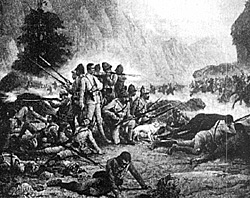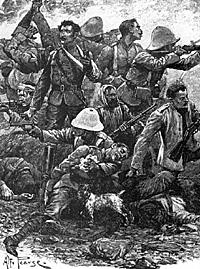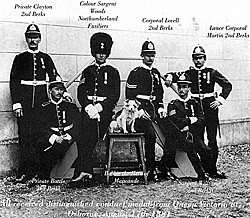 In July 1880 an officer and nine men of the 66th (Berkshire)
Regiment prepared to fire a final volley at over 30,000 Afghan
tribesmen who surrounded them. An Indian Army officer and two
regimental dogs, Nellie and Bobbie also formed part of the small
khaki square.
In July 1880 an officer and nine men of the 66th (Berkshire)
Regiment prepared to fire a final volley at over 30,000 Afghan
tribesmen who surrounded them. An Indian Army officer and two
regimental dogs, Nellie and Bobbie also formed part of the small
khaki square.
Ten years previously two troopships, the ' Serapis' and the Crocodile ' which had been carrying the soldiers of the 66th Regiment and their families to India had docked at the port of Valetta. Colonel Watson who had commanded the regiment had given the soldiers permission to go ashore. Sergeant Kelly had spotted a white puppy foraging for food in one of the the Maltese spotted a white puppy foraging for food in one of the the Maltese port's streets. The n.c.o . was fond of animals and he had smuggled the dog back aboard the ' Serapis ' under his red serge tunic just before the troopship sailed.
The sergeant had called the dog Bobbie. The soldiers had fed the pup with tit bits from their rations and the dog had slept in the n.c.o.'s hammock during the voyage to Alexandria. Bobbie had boarded the 'Malabar' at Suez which along with the 'Jumna' had taken the soldiers and their families on the second half of their voyage to India.
In 1880 after ten years service in the north-west region of the sub-continent, the 66th Regiment had been sent to Kandahar in Afghanistan. The British authorities were expecting trouble. News had been brought to the garrison that the Afghan leader Ayub Khan was intending to march on the town and drive the British back through the Khyber Pass. A field force had quickly been organised to intercept the Afghan army.
On 4th July the flying column consisting of over 2,600 men had marched out of Kandahar to stop the tribesmens' advance. Commanded by Brigadier-General Burrows, the force had consisted of the 3rd Sind Horse, 3rd Bombay Light Cavalry, Ist Bombay Grenadiers, 30th Bombay Native Infantry (Jacob's Rifles) and a detachment of Bombay Sappers and Miners.
The Indian regiments had been supported by a battery of Royal Horse Artillery and six companies of the 66th Regiment. The nineteen officers and 497 men of the Berkshires wearing khaki tunics and sun helmets had been commanded by Lieutenant Colonel James Galbraith.
As the three mile long column had made it's way across the sun scorched plains, Bobbie who's white coat was covered with red dust had trotted ahead of the fifes and drums and the regimental colour party. On 27th July the field force's Indian cavalry scouts had reached the village of Mundabad which was situated on the banks of a deep dried out watercourse forty five miles from Kandahar. On the plain behind the village the cavalry troopers had sighted the Afghan army led by Ayub Khan.
The Afghan army had been much larger than intelligence reports had estimated. Ayub Khan had been joined by twenty thousand wild religious fanatics who had outnumbered the field force by ten to one.
 Over 30,000 tribesmen had surrounded the field force and had
bombarded it with their artillery. The Afghans had quickly advanced
towards the Berkshires, but had been beaten back by the regular
volley fire from the soldiers ' MartiniHenry rifles. The tribesmens'
second attack had concentrated on the section of the line held by the
Indian regiments, and this time the Afghans had been successful.
The cavalry and infantry had fallen back and the soldiers of the
66th, including Bobbie, had been forced to withdraw towards the
dried out water course firing as they retreated.
Over 30,000 tribesmen had surrounded the field force and had
bombarded it with their artillery. The Afghans had quickly advanced
towards the Berkshires, but had been beaten back by the regular
volley fire from the soldiers ' MartiniHenry rifles. The tribesmens'
second attack had concentrated on the section of the line held by the
Indian regiments, and this time the Afghans had been successful.
The cavalry and infantry had fallen back and the soldiers of the
66th, including Bobbie, had been forced to withdraw towards the
dried out water course firing as they retreated.
Sergeant Kelly had received a head wound during the withdrawal, but Bobbie had sprung to his defence. Barking loudly, the dog had kept the sword wielding tribes men at bay until the n.c.o. had been picked by the medical orderlies and carried to the rear. After escorting the sergeant back and making sure that he was in good hands, Bobbie had bounded back to his hard pressed mates who were defending the watercourse.
Colonel Galbraith who had been carrying the Queen's Colour had rallied the majority of the 66th's survivors in the dried out depression. The officer had decided to withdraw to Khig as the village's building's and walls would, have provide protection against the tribesmens' deadly rifle fire, but as the soldiers had begun to withdraw the colonel had been shot and killed. Retreating to the walled garden of Maiwand, about a hundred men of the regiment had mai stand against the tribesmen. Second Lieutenant Olivey who had been carrying the regimental colour had been shot. The standard's broken staff had been picked up by Second Lieutenant Honeywood, but he had also cut down by the Afghans' bullets. Sergeant-Major Cuppage had taken charge of the colour before he too had been killed by the enemies' deadly rifle fire.
Only two officers, Lieuteliant Chute of the 66th and Lieutenant Hinde of the Bombay Native Infantry and nine men had survived the Afghan fusilade along with Nellie and Bobbie, two of the regiment's dogs.
The small group had prepared to make a last stand and the eleven men had formed square. Standing back to back, the soldiers had loaded their rifles and prepared to fire their final volley. Seconds after they fired, the Afghans poured a torrent of rifle fire on the tiny group before moving in to finish the job with their knives and swords.
The survivors of the battle including Sergeant Kelly began the forty five mile journey back to Kandahar. The worn out men were met on the track by a relief column commanded by General Brooke who had marched from Kokeran to escort them back to Kandahar. Five weeks after the battle, a small white dog covered with blood limped into the 66th's barracks at Kandahar. Sergeant Kelly who was sitting on his bunk could hardly believe his eyes. More than half of the regiment had been wiped out, but Bobbie had managed to make his way back through hostile territory. The mongrel was the only survivor from the small group who had faced the Afghan tribesmen at Maiwand.
On 19th January 1881 the regiment consisting of fifteen officers and 461 men left Afghanistan for Bombay where it embarked for England. On landing at Portsmouth in February the regiment was stationed at Parkhurst Barracks on the Isle of Wight. The officers and men were inspected by the Duke of Cambridge on I Ith February.
That same year the 66th was amalgamated with the 49th Regiment to become the second battalion of the Berkshire Regiment. The regiment was to receive new colours from the Queen to replace the standards which had been lost on campaign.
Queen Victoria who was staying at Osbourne House on the Isle of Wight was a dog lover and she was especially keen to meet Bobbie. The regimental wives decided to make the dog a special coat for the presentation. After taking the dog's measurements, the women made Bobbie a red velvet coat which was decorated with imitation pearls in the shape of a crown. Two good conduct stripes had also been sewn on to Bobbie's regimental jacket to signify that he had completed five years service in the British Army.
On 17th August 200 men of the second battalion commanded by Colonel Hogge marched to Osborne House with Bobbie to receive the regiment's new colours. The regiment formed up in a square in front of the house. When Queen Victoria saw Bobbie she mistook the little mongrel for a Pomeranian. She was curious to see to see where he had been wounded, and the dog was lifted on to a table so that the monarch could take a good look at him.
 To acknowledge the heroism he had shown at the Battle of Maiwand, Bobbie was awarded with the campaign medal along with the rest of his comrades. A photograph (at right) was taken of Bobbie, and five other survivors of the battle for the Queen's collection.
To acknowledge the heroism he had shown at the Battle of Maiwand, Bobbie was awarded with the campaign medal along with the rest of his comrades. A photograph (at right) was taken of Bobbie, and five other survivors of the battle for the Queen's collection.
Large Survivors Photo (slow: 117K)
Bobbie did not live long enough to get his three good conduct stripes which would have been awarded to him after twelve years service, as he was run over by a hansom cab in Gosport the following year. In 1882 artist Frank Feller included Bobbie in his painting 'The Last Eleven' which depicted the final stand of the soldiers of the 66th at Maiwand.
Although Bobbie is immortalised on canvas he can also still be seen as the only animal to be decorated by a reigning monarch was preserved by the Regiment. Bobbie who is wearing his Afghan War medal sits bright eyed and bushy tailed in a glass case in the Duke of Edinburgh's Royal Regiment's Museum at Salisbury, Wiltshire.
References
Silent Heroes Evelyn Le Cherie
The Royal Berkshire Regiment F. Loraine Petre
Back to Age of Empires Issue 14 Table of Contents
Back to Age of Empires List of Issues
Back to MagWeb Master List of Magazines
© Copyright 1998 by Partizan Press.
This article appears in MagWeb (Magazine Web) on the Internet World Wide Web.
Other military history articles and gaming articles are available at http://www.magweb.com